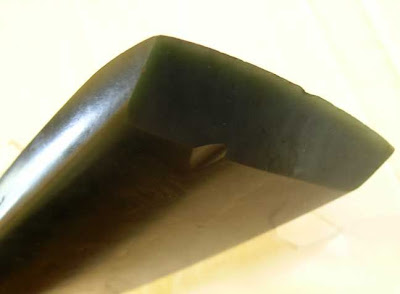Several of his exhibits came from his father, a famous geologist and head of a university geology department. One of these items was an “axe” that supposedly came from Australia and was beautifully fashioned in a green mineral. So clean were its lines that it wasn’t clear that the “axe” was not machine- made and therefore a fake or a hoax.


Almost fifty years later, our museum curator, now retired from a career in the oil business, decided to downsize his possessions and this process meant getting rid of a few of the last-remaining exhibits from his original collection. This included the “axe” and it was listed on eBay, making sure that a clear description was given, together with the doubts over its authenticity.
One prospective bidder sent many detailed questions concerning the “axe” and he ended up as the winner of the on-line auction. And then things got really exciting. Since its original creation, the “axe” had a most remarkable journey and ended up back in its country of origin, New Zealand. The Te Papa (the NZ national museum) confirmed the eBay buyer’s hunch that it was an original and very fine Maori toki or adze. It was made from nephrite (a type of jade) and was probably ceremonial and of some antiquity.
Once it returned to New Zealand it became protected from export, being classified as a Toanga Tuturu or national cultural treasure. The buyer was a private collector, though registered with the government and allowed to legally own such items. He truly believes that we never actually own such things but are merely their custodians as they will far outlast us and the adze will eventually be donated to Te Papa. This is its certificate confirming its origin and its status as a national treasure.


The photos that had been included in the eBay listing apparently showed a unique characteristic not usually found in modern reproductions. Also, the silky, satin-like surface texture is only found on hand ground tools. The adze is in remarkably good condition with a very sharp fine cutting edge. The Maori were the finest wood carvers in Polynesia and their tools reflect that.


On the adze’s journey across the world, one can only speculate. The Victorians were great collectors of cultural items from the "Empire" and many fine Maori pieces are still in Europe. The eBay price realised was a few hundred UD dollars but the monetary worth of the adze, if sold at conventional auction, would be measured in thousands, rather than hundreds of dollars. But that is not the point. The adze has indeed returned to its literal and spiritual home and that, without doubt, is a truly delightful outcome.
Hi William, What an interesting story! We plan to share it with our friends in New Zealand :)
ReplyDeleteMarjie & John